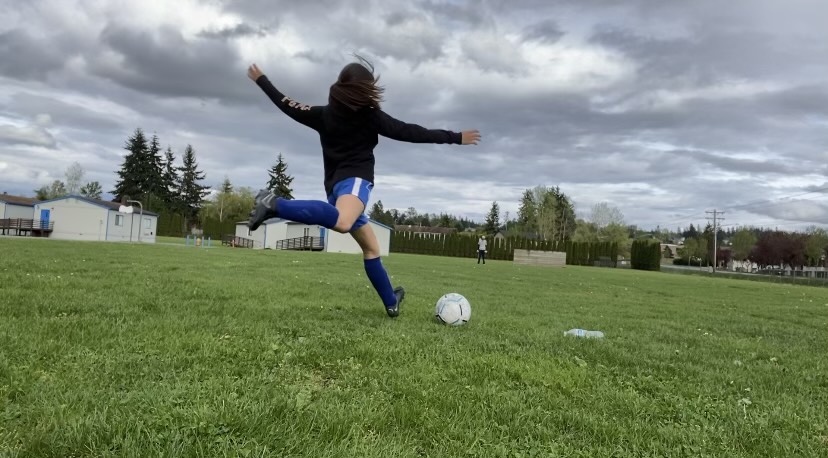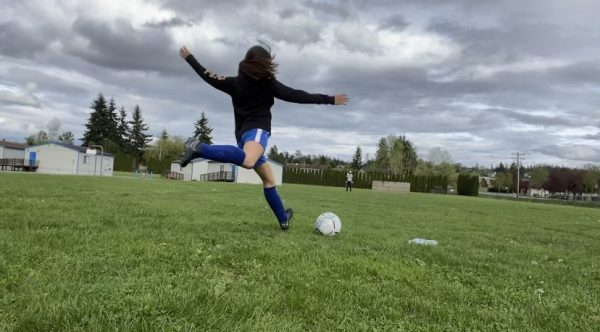The Expectations V.S. Reality of Competing in Track and Field
Taking a quick insight into their daily lives of Track & Field competitors
John Timothy Heist and Landon Speidel running their 200m to the finish line vs. Arlington on Monday, April 17th 2023. ( Ellie Tredway)
May 10, 2023
Is track actually that difficult? How much skill does it really take to run fast, throw far or jump far? This is a question that many people observing track meets ask. The truth is that it is difficult, and requires a lot of skill. Runners have to be fast, work on form, staying in their lane and breathing. Jumpers have to focus on their steps, height, and form. Throwers have to focus on their strength, form and staying inside their throwing space.

The 100m and 200m are fairly similar events, in the sense that you sprint full speed the entire time. For the 100m, sprinters run around ¼ of the track A.K.A. one straight away. For the 200m, sprinters run around ½ of the track, typically starting on the curve and then straight away. As strange as this may sound, running isn’t just running. Not only is sprinting tiring, but sprinting around the track takes both speed and endurance. It also takes the right mindset. When running, it’s hard to concentrate on your breathing and being in the right formation, causing it to be difficult for sprinters to develop their speed due to focusing on other things. Then the 400m and the 800m are also super difficult despite the fact that, on paper, one or two laps around the track can’t be that bad(400m is 1 lap around the track and 800m is 2). While these events are considered “distance events,”’ runners still sprint to the finish line and around the track like the “dashes.” Not only do you need speed for these events, but you also need endurance and pacing. This makes this a harder event than most people think.

The 1600m and the 3200m are some of the most difficult events that happen during track meets. The 1600m or 1 mile is 4 laps around the track while the 3200m or 2 mile is 8 laps. It takes the right amount of time and power to push yourself to the end. It’s not an easy task to compete when you have to have the right mentality and physicality. It also scares most people to even try out for those types of events, since it takes up the most time from start to finish; athletes will often focus on a type of object or song to occupy their thoughts while enduring the entire length of the event. Warming up comes up also when you have to be ready to run those events, it takes the time and patience to make it easier to get the right mindset. People don’t really realize that it takes so much preparation to get yourself ready to run. The process starts off with actually wanting to do the 1600 or the 3200. Running even 4 laps or 8 laps around the track sounds super easy to say but it takes so many things to warm up for them let alone compete in them.

Hurdles takes a lot of skill and brainpower, making it one of the more mentally challenging events. During Hurdles, runners run either 100m or 300m and jump over hurdles at the same time. Not only do you have to focus on your steps and jumps, you also have to focus on getting over the hurdle and getting over the fear of jumping over the hurdle. To people who don’t do hurdles, they may seem pretty simple, just run and jump right? Well while that is what you do, run and jump, it’s actually a lot harder than it may seem. Both mentally and physically, hurdles are a challenging task, even to experienced hurdlers.
Relays take the right timing and the right balance to be ready for the baton. The relays consist of the 4x200m, 4x100m, and the 4x400m. Those events are super difficult to get the right timing and handing it off to your other teammates. In relays you run the distance specified (Example: 4x100m = 100m) and then pass a baton to your teammate who is then going to run the same distance.Trying to rely on your own teammates to run out in front of you at the right time and the right grip on the baton. All of the events are basically sprinting and are the most exciting events of the day/night. Sprinting can also get super tiring so pacing yourself is a good thing.
Throwing events consist of Javelin, Discus and Shot. In Javelin the goal is to throw a long pole across the field as far as you can. From the stands, throwing a pole may not seem that far, but when you’re far away from where the actual event is taking place, you don’t realize how far these people are really throwing. Some people can throw a Javelin as far as 60m, some people even more. This takes both lots of muscle and good form. Same goes for all throwing events. In Discus the goal is to throw a heavy disk as far as you can. In Shot the goal is to throw a weighted ball as far as you can. “It’s really down to technique,” says 9th grade Track athlete Edward Kuhrau, also known as Ted, “I’ve thrown varsity every meet and just knowing that I’ve gone from the bottom to the third or fourth best thrower on the team is just great… It’s rewarding.” Throwers have to really focus on their form or else they will get injured, a prime example is Ted who injured his elbow last year. They also have to get over mental blocks of believing you’re not good enough especially when competing with throwers with more experience and power then them.

Jumps and pole vault are very demanding events, they are very competitive during the day and sometimes in the night lasting longer than the meet. Jumps consist of Long Jump, High Jump, and Triple Jump that take the right momentum and right agility to go further than you think you can. It makes a person think they can’t even go that far or pull themselves up. It also takes the right mindset to push yourself to get in the right position, that takes a lot of time to get in. Taking so many tries, that’s even scary to jump over a bar or in the sand. Maisy Wagner says the most challenging aspect is “that you have to do so many different tiny details in the span of six seconds to go over and complete the vault.” Pole vault on the other hand really takes the right mindset, it is a long pole that you have to pick yourself over a bar to place. Maisy Also says “It takes a lot of effort to jump, then having to do it multiple times even being really scared to even do them and being able to even pick yourself up.” Overall it is really scary to jump and do pole vault but taking the time to do it to improve can help.
There are many things that affect track meets such as wind, precipitation and temperature. Wind affects running events, in the sense that if you are running with the wind, it is slightly easier to accelerate, and if you’re running against the wind it is harder to accelerate. Wind affects throwing in the sense that when you throw with the wind it can slightly help make your throw further and can help with momentum of you yourself preparing to throw, but when you are throwing against the wind it can shorten your throw slightly and make it harder to build momentum while preparing to throw.
All in all, track is a very difficult sport to compete in despite how easy it may look. When having to balance with school it can get hard sometimes, it can take so many different chances and improvements to get where these teenagers are today. From mental blocks to form and determination, track is more than just running and jumping. It’s about the willingness to improve in whatever event these athletes are in, taking time in their day to excel.







































